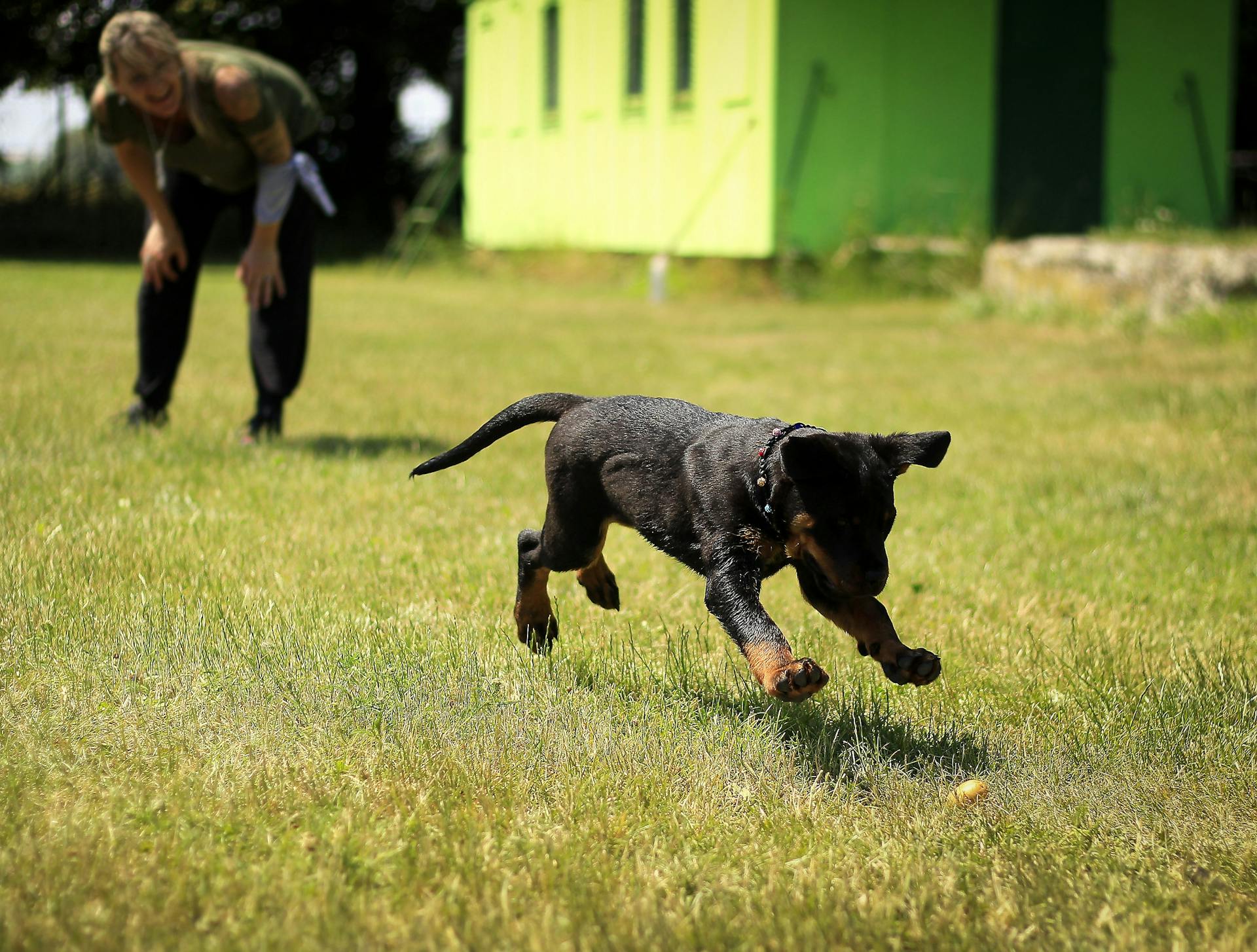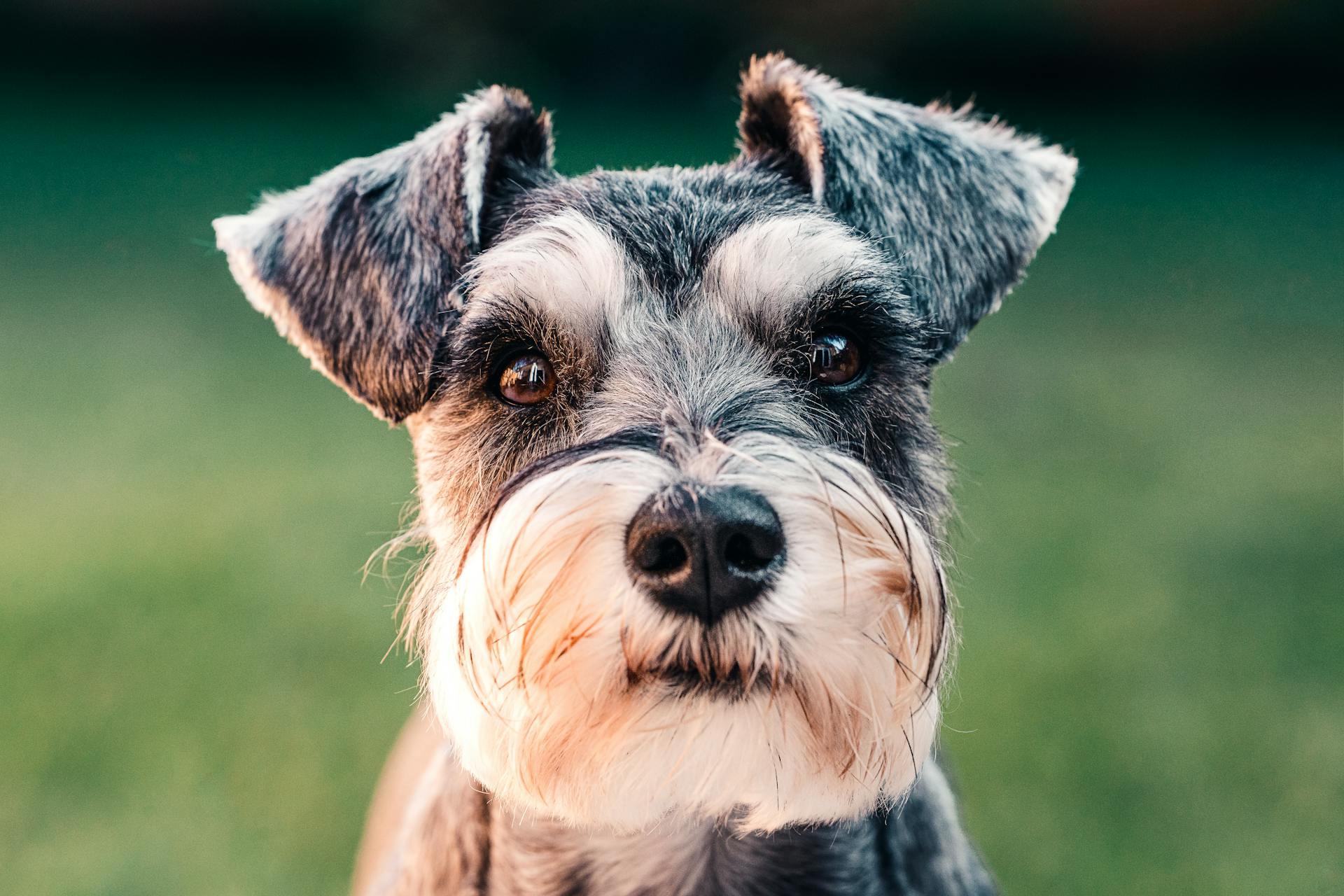
Albino dogs are a rare and unique breed, with only a few known cases worldwide.
Their lack of pigmentation makes them highly sensitive to the sun, requiring extra precautions to prevent sunburn and skin damage.
Albino dogs have a 1 in 100,000 chance of being born, making them extremely rare.
Their vision is often impaired due to the absence of melanin, which can cause blind spots and reduced visual acuity.
These dogs require special care and attention to ensure their well-being and safety.
Albinism in Dogs
Albinism in dogs is a recessive trait, meaning a dog needs to inherit two copies of the mutated gene to display the condition. This can result in a white to off-white coat and blue/gray eyes.
Some breeds, like the Lhasa Apso, Pomeranian, Pekingese, French Bulldog, and Pug, can have this exact mutation, which is also known as "small-breed variety" albinism. This mutation affects the SLC45A2 gene.
Dogs with albinism can be sensitive to light and appear to have visual problems in bright sunlight, so some owners put tinted goggles on their dogs to protect their eyes. The Doberman Pinscher Club of America does not condone breeding these dogs due to their sensitivity to light.
Here are some breeds that can be prone to albinism:
- Lhasa Apso
- Pomeranian
- Pekingese
- French Bulldog
- Pug
- Doberman Pinscher
- Bullmastiff
- Shih Tzu
- Beagle
- Dachshund
Doberman Pinscher Albinism
Doberman Pinscher Albinism is a rare condition found exclusively in this breed. It's caused by a mutated SLC45A2 gene with a substantial amount of code deleted.
The Doberman Pinscher Club of America does not condone breeding albino Dobermans due to their sensitivity to light and potential visual problems.
Albino Dobermans have blue/gray eyes, pink skin, and coat color dilution, resulting in an off-white coat. They can produce some pigment in their hair, but it's not enough to produce a full coat color.
This form of albinism is a recessive trait, meaning albino Dobermans have two copies of the mutated gene.
White Dobermans can be tested for this mutation through the UC Davis Veterinary Genetics Laboratory, Neogen Paw Print Genetics, or Animal Genetics.
The Doberman Pinscher Club of America acquired two white dogs for test matings, which produced only colored offspring. This was consistent with a recessive mode of inheritance.
Dogs that descend from a famous Doberman Pinscher named Sheba, who was born in 1976, can be identified by the "WZ" code before their American Kennel Club registration numbers.
White Swiss Shepherd
The White Swiss Shepherd is a rare breed, recognized by the Fédération Cynologique Internationale, but not by the American Kennel Club.
These dogs have a white coat, pointed ears, and a sweet smile, making them a great pet for many families.
As a herding breed, White Swiss Shepherds are attentive and agile, great with kids, and very loyal to their owners.
They have an intense desire to work and learn, which makes training easy and enjoyable.
In fact, they excel in beginning obedience training and even in dog sports like agility or competition obedience.
The only downside to owning a White Swiss Shepherd is that they can be hard to find in North America.
Their rarity makes them a unique and special addition to any family.
Discover more: German Shepherd Dogs 101 Animal Planet
Health Risks
Albino dogs are prone to certain health issues due to their lack of protective pigment in the eye and skin. Most albino dogs live normal lifespans, but they may have more eye and skin tumors than non-albinos.
Their skin is more exposed to UV rays, which can cause damage to the eye's lens and internal structures, as well as skin cancer. Albino dogs are more prone to developing metastatic skin cancers.
Some specific health risks include:
- Increased risk of eye tumors and skin tumors
- Risk of skin cancer due to lack of protective pigment
- Possible poor vision or blindness from birth
It's essential to monitor their health closely and be aware of any changes in their skin, such as bumps, non-healing sores, or other abnormalities. Regular vet visits can help identify any potential issues early on.
They're at Higher Health Risk
Albino dogs are more prone to health issues, including skin cancer and unfixable eye abnormalities.
Having two copies of the merle gene can lead to other genetic deformities.
Albino dogs are especially sensitive to light, which can cause skin cancer and other skin problems.
Any bumps, non-healing sores, or changes in their skin should be monitored and reported to your vet.
Albino dogs are also more likely to have poor vision or be blind from birth due to eye deformities.
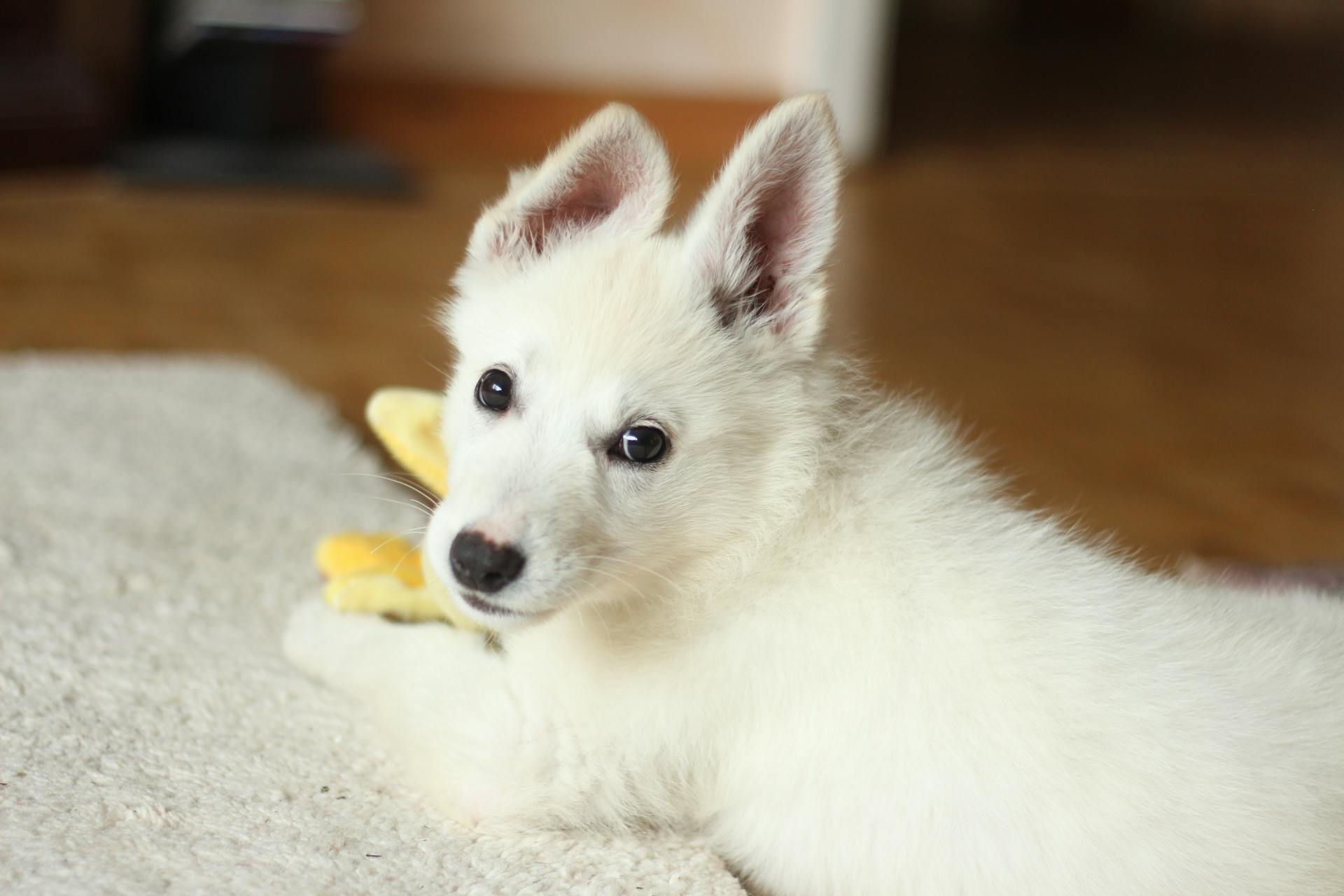
UV light causes aging and damage to the eye's lens and internal structures, including the lens and retina, and to the body's skin.
This means that albino dogs are more prone to developing metastatic skin cancers.
Their skin is more exposed to these UV rays because there is no protective layer to help shield them.
An albino dog's pupil is relatively useless because of the lack of pigment in the iris.
The iris allows most of the light to travel right through it, so it makes no difference if the pupil is open wide or constricted to its smallest size.
Albino dogs typically have to squint when in bright light because of this situation.
They also have a hard time seeing even in normal lighting because of the way their eyes work.
Albino dogs never have an effectively constricted pupil, which means they likely have poorer visual acuity.
For another approach, see: Best Dog Food for Dogs with No Teeth
Deafness
Deafness is a significant health risk in some dog breeds. Over 80 dog breeds have reported cases of congenital deafness. Dalmatians are the most common breed affected, but white Bull Terriers, English Setters, Cocker Spaniels, and Australian Cattle Dogs also have high rates of deafness.
A different take: Dog Breeds Watch Dogs
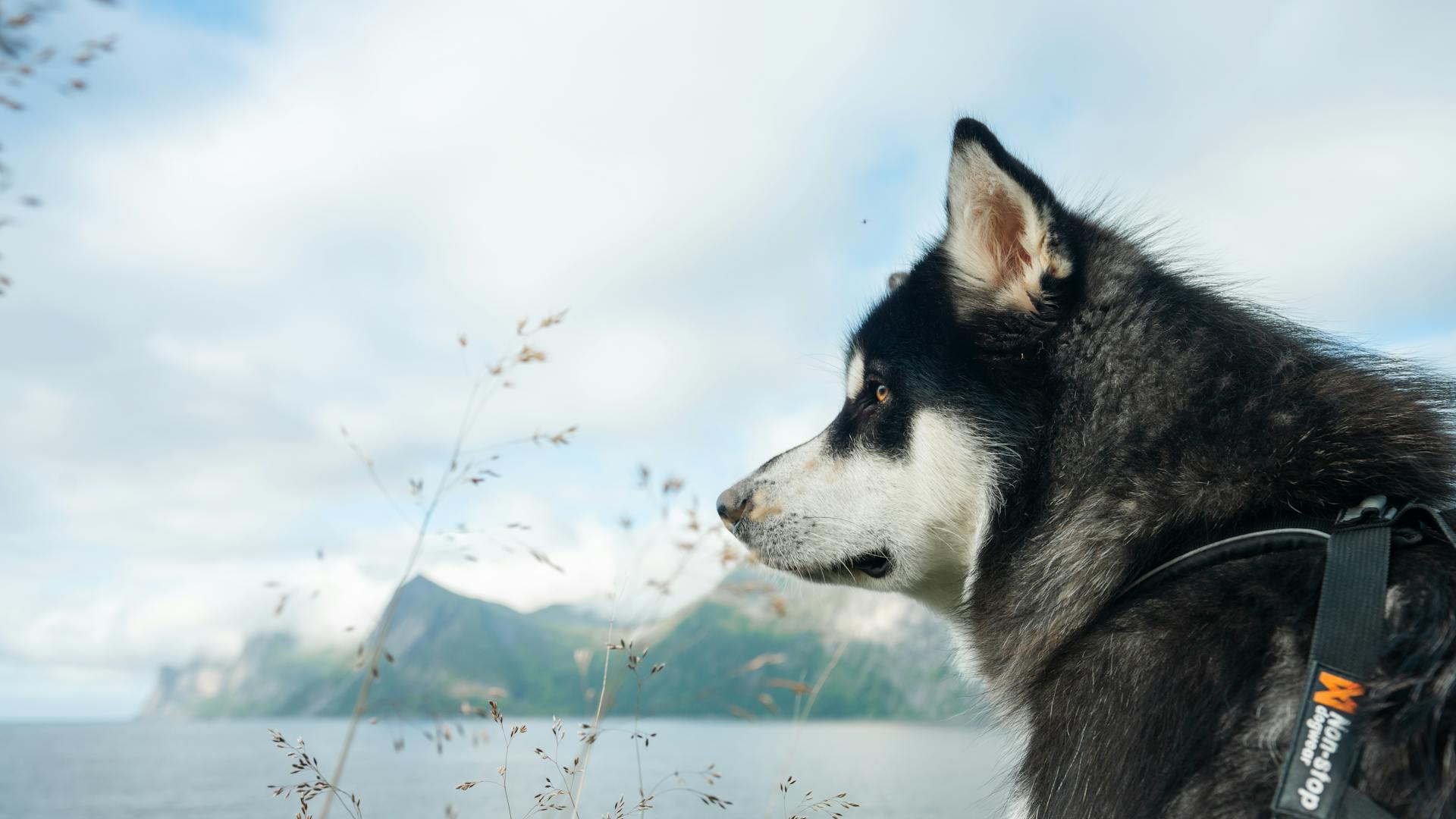
Certain genetic factors increase the risk of deafness in dogs. Breeds with merle or extreme white spotting genes, such as Great Danes, Australian Shepherds, and Border Collies, are more likely to have deaf pups. Dalmatians have a gene for extreme piebald spotting, which also suppresses melanocytes and increases the risk of deafness.
Dogs with deafness often have other distinctive physical characteristics. They may have blue eyes, pink skin around the eyes, and a pink nose. In fact, dogs with deafness are more likely to have blue eyes than dogs with normal hearing.
Here are some key physical characteristics to look out for in dogs with deafness:
- Pink skin around the eyes
- Purely pink nose
- Blue/gray eyes
- Off-white or pure white coat
- Paw pads are pink only
It's essential to be aware of these physical characteristics and genetic factors to identify dogs that may be at risk of deafness.
Rare and Special Cases
True albinism is extremely rare in dogs, as they must lack the genes necessary to produce melanin, the pigment responsible for skin and hair coloring.
Merle patterning, on the other hand, is a dominant trait that can be inherited from just one parent, resulting in a distinctive coat pattern found in breeds like Australian Shepherds and Great Danes.
Albinism occurs more frequently when dogs have two copies of a recessive gene, which causes the characteristics of albinism to appear.
The Doberman Case
The Doberman Pinscher breed is most identified with albinism, a rare genetic condition caused by a mutated SLC45A2 gene.
This form of albinism is recessive, meaning that a dog must inherit two copies of the mutated gene to express the trait.
The condition results in blue/gray eyes, pink skin, and coat color dilution, giving the dog an off-white coat.
It's worth noting that the Doberman Pinscher Club of America does not condone breeding these dogs due to their sensitivity to light and potential visual problems.
White Dobermans can be identified by the presence of the "WZ" code before their American Kennel Club registration numbers.

The condition can be traced back to a famous Doberman Pinscher named Sheba, who was born in 1976 and bred to produce more white Dobermans.
To test for this mutation, owners can send their dog's DNA to the UC Davis Veterinary Genetics Laboratory, Neogen Paw Print Genetics, or Animal Genetics.
Lhasa Apso Albinism
Lhasa Apso Albinism is caused by a substitution mutation in the genetic code of the SLC45A2 gene.
This mutation is recessive, which means a dog needs to inherit a copy of the gene from each parent to be albino.
The Lhasa Apso Albinism, or LAA, is not exclusive to Lhasa Apsos, as other breeds like Pomeranians, Pekingese, French Bulldogs, and Pugs have also been noted to have this exact mutation.
Dogs with LAA will have a white to off-white coat and blue/gray eyes.
Some laboratories can test your dog's DNA for this specific mutation, including simply carrying one albino gene.
You can visit the UC Davis Veterinary Genetics Laboratory, Neogen Paw Print Genetics, or Animal Genetics for more information.
Understanding Albinism
Albinism in dogs is caused by a mutation in the SLC45A2 gene, which codes for a protein used in making the pigment melanin.
The lack of pigment in albino dogs makes their skin sensitive to sunlight and prone to sunburn and skin cancer.
Some laboratories can test your dog's DNA for this specific mutation, including simply carrying one albino gene.
Albino dogs have a high risk of skin, lip, eyelid, and iris tumors due to the lack of pigment.
To protect their eyes, some people put tinted goggles on their dogs to prevent eye problems caused by the mutation.
The Doberman Pinscher Club of America does not condone breeding albino Dobermans due to their sensitivity to light and potential visual problems.
Albino dogs can have blue or gray eyes and a white or off-white coat, but not pink eyes as some people might think.
A DNA test can determine if a Doberman carries the mutation that causes albinism, which is a 4,081 base pair deletion of the SLC45A2 gene.
Most albino dogs will have blue eyes and pink noses, but not all white dogs are albino, as some can have dark eyes or noses.
Companionship and Care
Albino dogs can make wonderful companions, despite requiring extra care due to their sensitive skin and vision.
They need protection from the sun, so it's essential to apply sun protectors with the highest UV rating possible to areas that can't be covered, like the nose and belly.
Albino dogs can thrive with proper care, and some have even excelled in AKC companion sports.
For example, an albino Doberman named Sprite achieved several advanced titles in Obedience and Agility, showing that with the right care, albino dogs can do just about anything other dogs can.
White Dog Breeds You'll Love
You'll love these white dog breeds for their unique characteristics and adorable looks. Many white dogs got their pure-white coats because they had jobs to do, such as guarding flocks of white sheep.
Some breeds developed all-white coats as a kind of camouflage in snowy climates. Not everything is functional, and sometimes it's just about looking pretty.
The white Swiss shepherd is a great pet with a white coat, pointed ears, and a sweet smile. They're a herding breed by nature, which means they're attentive and agile.
White Swiss shepherds have an intense desire to work and learn, making them easy to train. They excel in dog sports such as agility or competition obedience.
Breeds that are commonly white include the Bichon Frisé, Samoyed, Japanese Spitz, Maltese, West Highland White Terrier, Coton de Tulear, Poodle, and Bull Terrier.
Animal Companionship
Albino dogs can make wonderful companions if you take good care of them.
They require extra care due to their lack of pigmentation, which makes them more susceptible to health issues.
Their skin needs protection from the sun, so it's essential to apply sunscreen with the highest UV rating possible, especially on bare skin like the nose and belly.
Wearing protective clothing, such as a coat or clothes, can also help shield their skin from the sun.
Protecting their eyes is also crucial, as they can be sensitive to light.
Sunglasses and goggles can be used to shield their eyes from the sun, and dressing them in protective coats or clothes can also provide extra protection.
With proper care, albino dogs can live a long and happy life, just like any other dog.
They can even excel in dog sports, such as agility and obedience, if you take good care of their skin and eyes.
For example, an albino Doberman named Sprite achieved several advanced degrees in obedience and agility through the AKC.
Intriguing read: Agility Class Dogs
Stock Photos
There are over 520+ albino dog stock photos and images available online.
Albino dogs have a unique appearance, often with pink noses and blue eyes.
A curious albino dog can make for a great stock photo, especially when looking straight into the camera.
The white coat of an albino dog can be a striking feature in a photograph, especially against a contrasting background like tall grass.
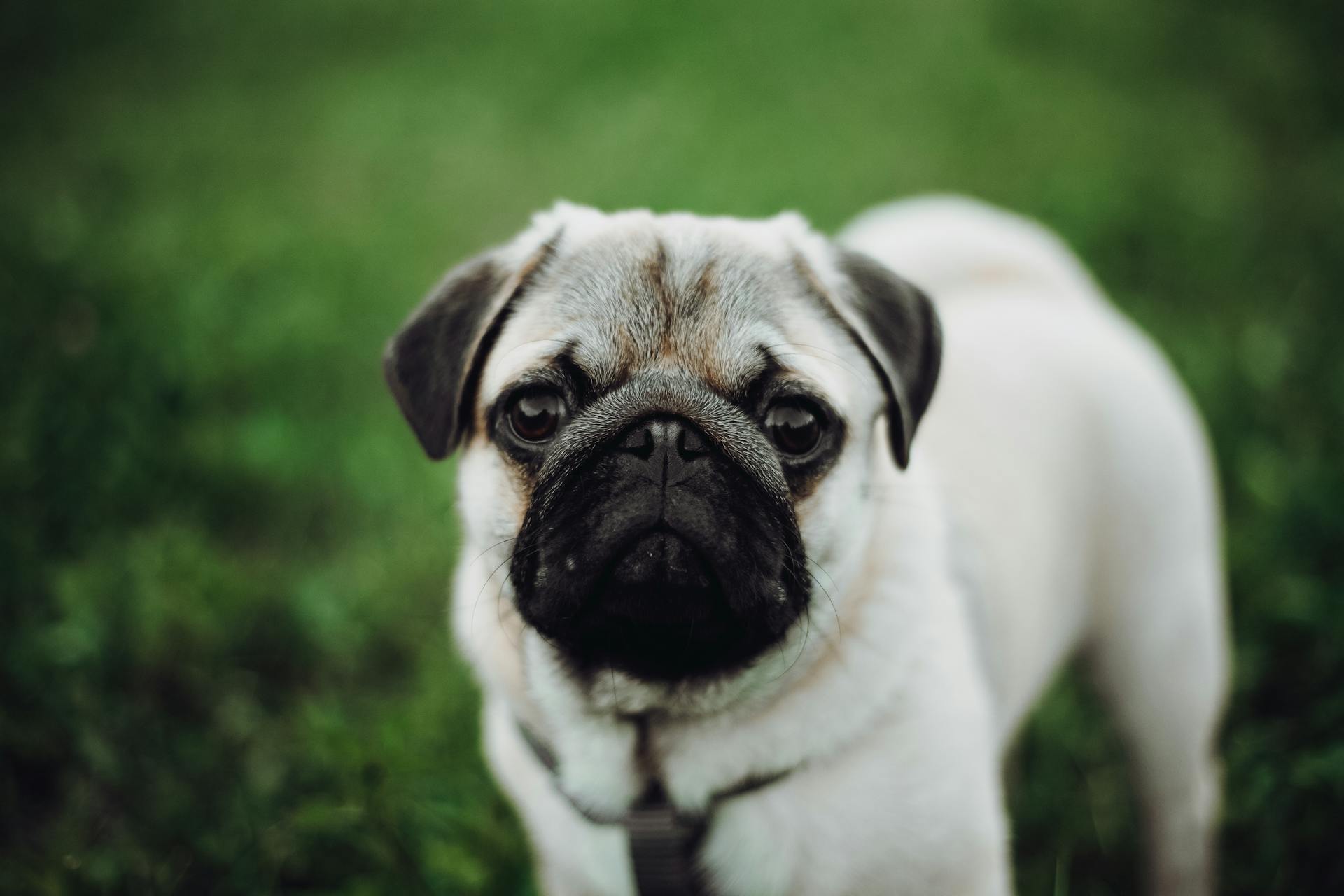
Albino dogs can be found in various breeds, such as the Great Dane and the Dalmatian.
Heterochromia, or eyes of different colors, can add an extra layer of interest to a stock photo of an albino dog.
A close-up portrait of a white dog with heterochromia can be a unique and special image.
Featured Images: pexels.com
